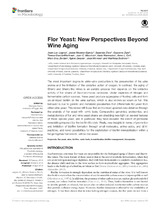Flor Yeast: New Perspectives Beyond Wine Aging
Autor
Legras, Jean-Luc
Moreno-García, Jaime
Zara, Severino
Zara, Giacomo
García-Martínez, Teresa
Mauricio, Juan C.
Mannazzu, Ilaria
Coi, Anna L.
Zeidan, Marc Bou
Dequin, Sylvie
Moreno, Juan
Budroni, Marilena
Editor
Giuseppe SpanoFecha
2016Materia
Flor yeastWine
Biofilm
-Omic tools
Immobilization
Biofilm management
Biocapsules
METS:
Mostrar el registro METSPREMIS:
Mostrar el registro PREMISMetadatos
Mostrar el registro completo del ítemResumen
The most important dogma in white-wine production is the preservation of the wine
aroma and the limitation of the oxidative action of oxygen. In contrast, the aging of
Sherry and Sherry-like wines is an aerobic process that depends on the oxidative
activity of flor strains of Saccharomyces cerevisiae. Under depletion of nitrogen and
fermentable carbon sources, these yeast produce aggregates of floating cells and form
an air–liquid biofilm on the wine surface, which is also known as velum or flor. This
behavior is due to genetic and metabolic peculiarities that differentiate flor yeast from
other wine yeast. This review will focus first on the most updated data obtained through
the analysis of flor yeast with -omic tools. Comparative genomics, proteomics, and
metabolomics of flor and wine yeast strains are shedding new light on several features
of these special yeast, and in particular, they have revealed the extent of proteome
remodeling imposed by the biofilm life-style. Finally, new insights in terms of promotion
and inhibition of biofilm formation through small molecules, amino acids, and di/tripeptides,
and novel possibilities for the exploitation of biofilm immobilization within a
fungal hyphae framework, will be discussed.

